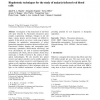Free Online Productivity Tools
i2Speak
i2Symbol
i2OCR
iTex2Img
iWeb2Print
iWeb2Shot
i2Type
iPdf2Split
iPdf2Merge
i2Bopomofo
i2Arabic
i2Style
i2Image
i2PDF
iLatex2Rtf
Sci2ools
MBEC
2010
2010
Biophotonic techniques for the study of malaria-infected red blood cells
Investigation of the homeostasis of red blood cells upon infection by Plasmodium falciparum poses complex experimental challenges. Changes in red cell shape, volume, protein, and ion balance are difficult to quantify. In this article, we review a wide range of optical techniques for quantitative measurements of critical homeostatic parameters in malaria-infected red blood cells. Fluorescence lifetime imaging and tomographic phase microscopy, quantitative deconvolution microscopy, and X-ray microanalysis, are used to measure haemoglobin concentration, cell volume, and ion contents. Atomic force microscopy is briefly reviewed in the context of these optical methodologies. We also describe how optical tweezers and optical stretchers can be usefully applied to empower basic malaria research to yield diagnostic information on cell compliance changes upon malaria infection. The combined application of these techniques sheds new light on the detailed mechanisms of malaria infection providing ...
| Added | 20 May 2011 |
| Updated | 20 May 2011 |
| Type | Journal |
| Year | 2010 |
| Where | MBEC |
| Authors | Jakob M. A. Mauritz, Alessandro Esposito, Teresa Tiffert, Jeremy N. Skepper, Alice Warley, Young-Zoon Yoon, Pietro Cicuta, Virgilio L. Lew, Jochen R. Guck, Clemens F. Kaminski |
Comments (0)

